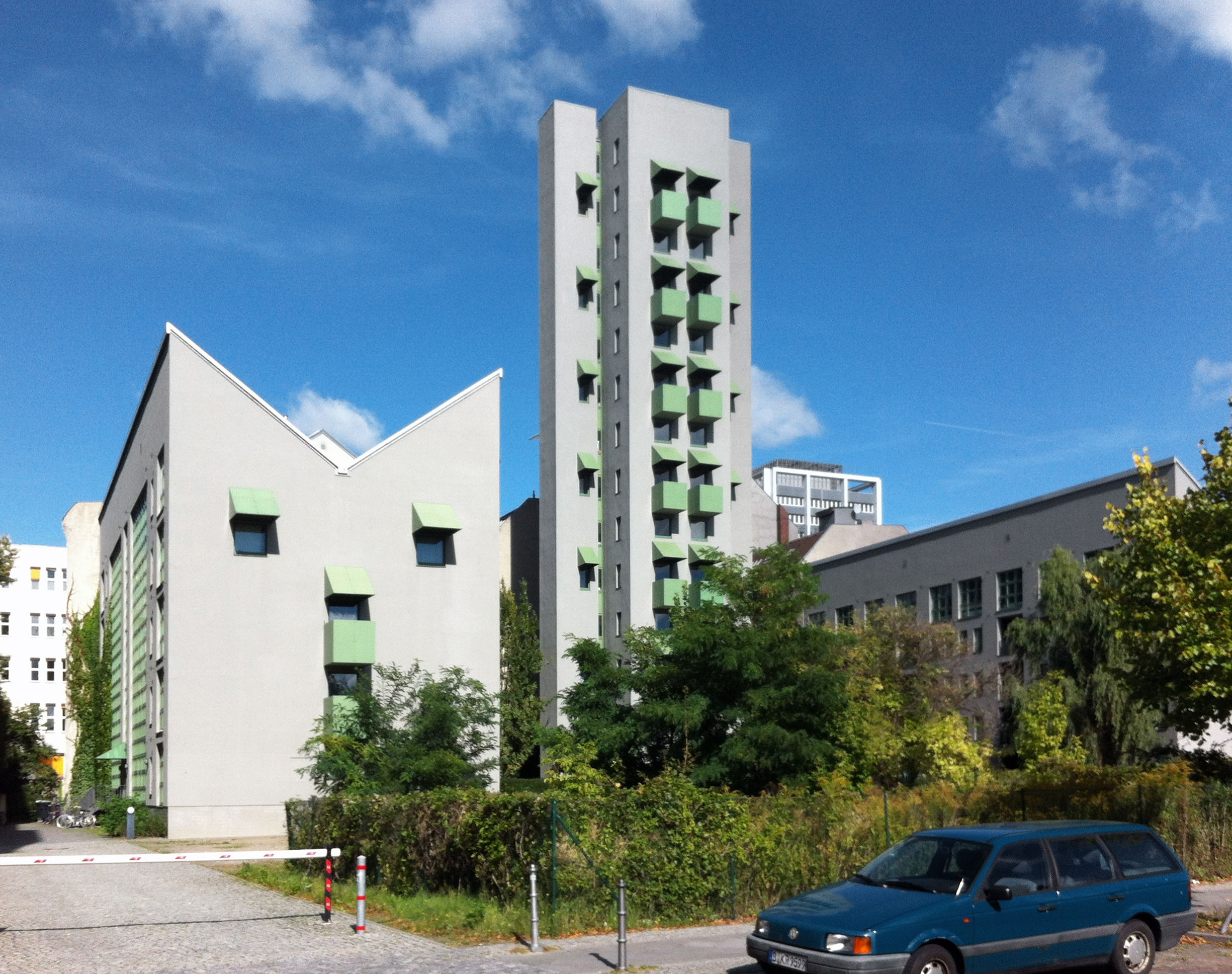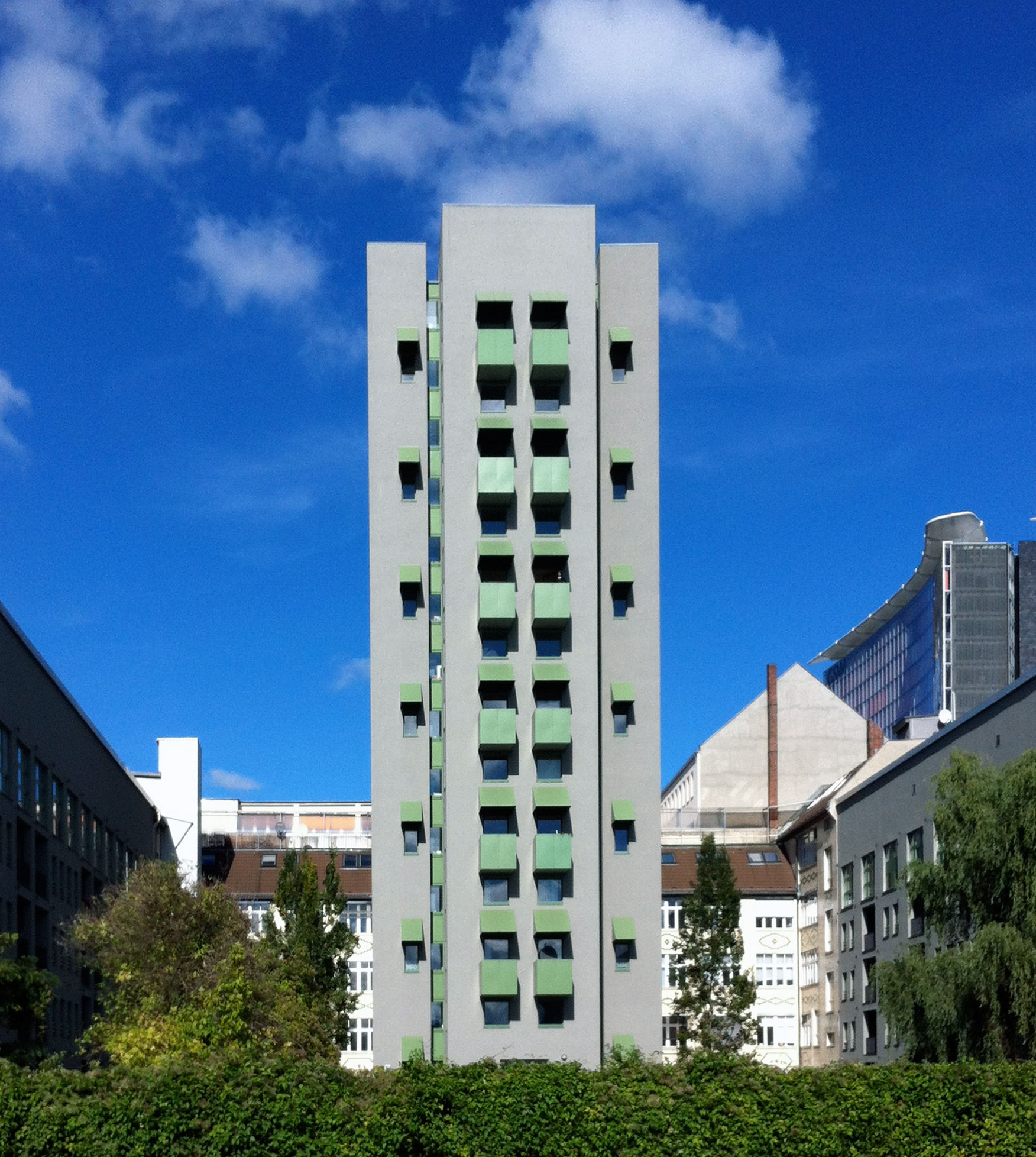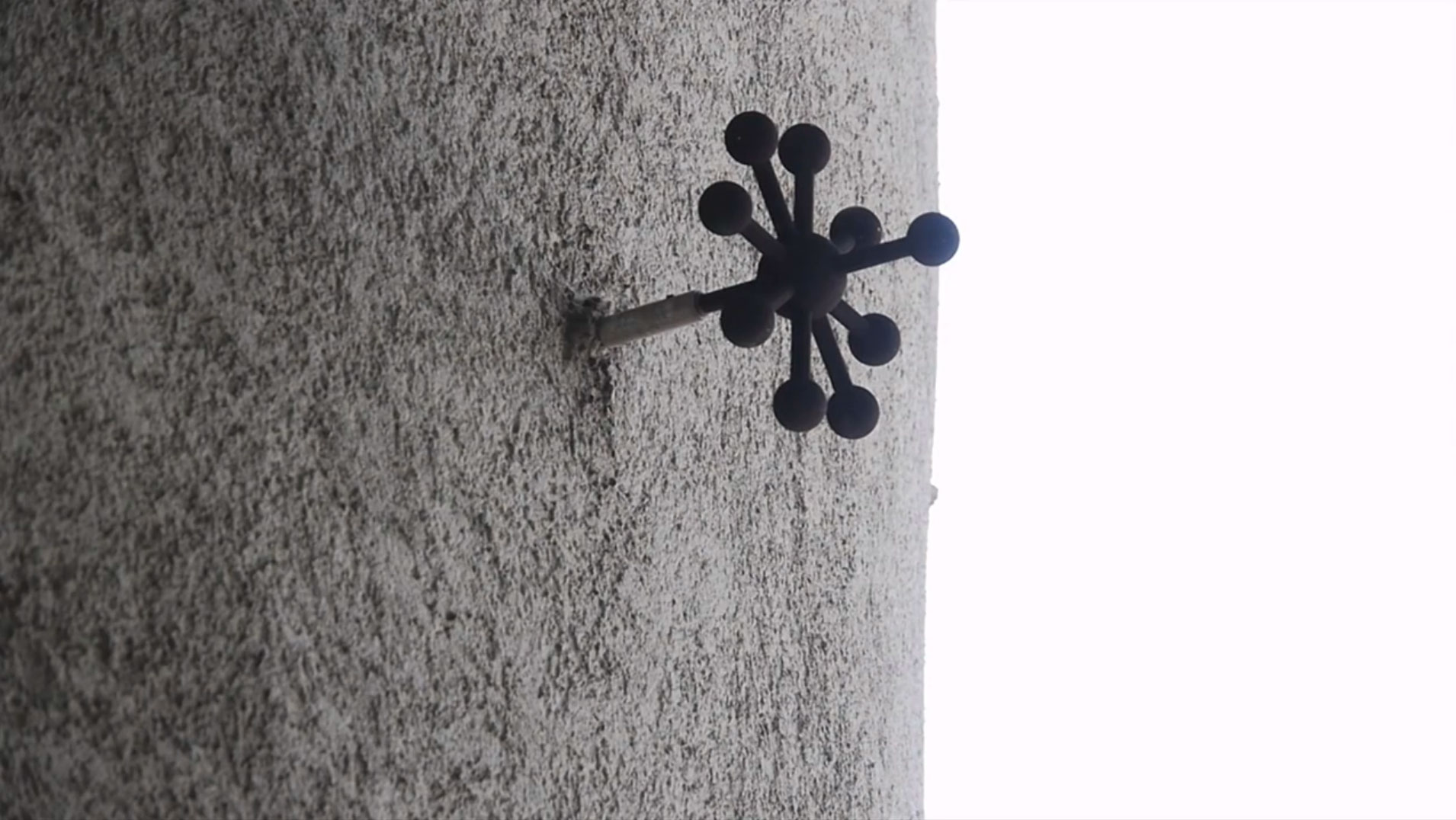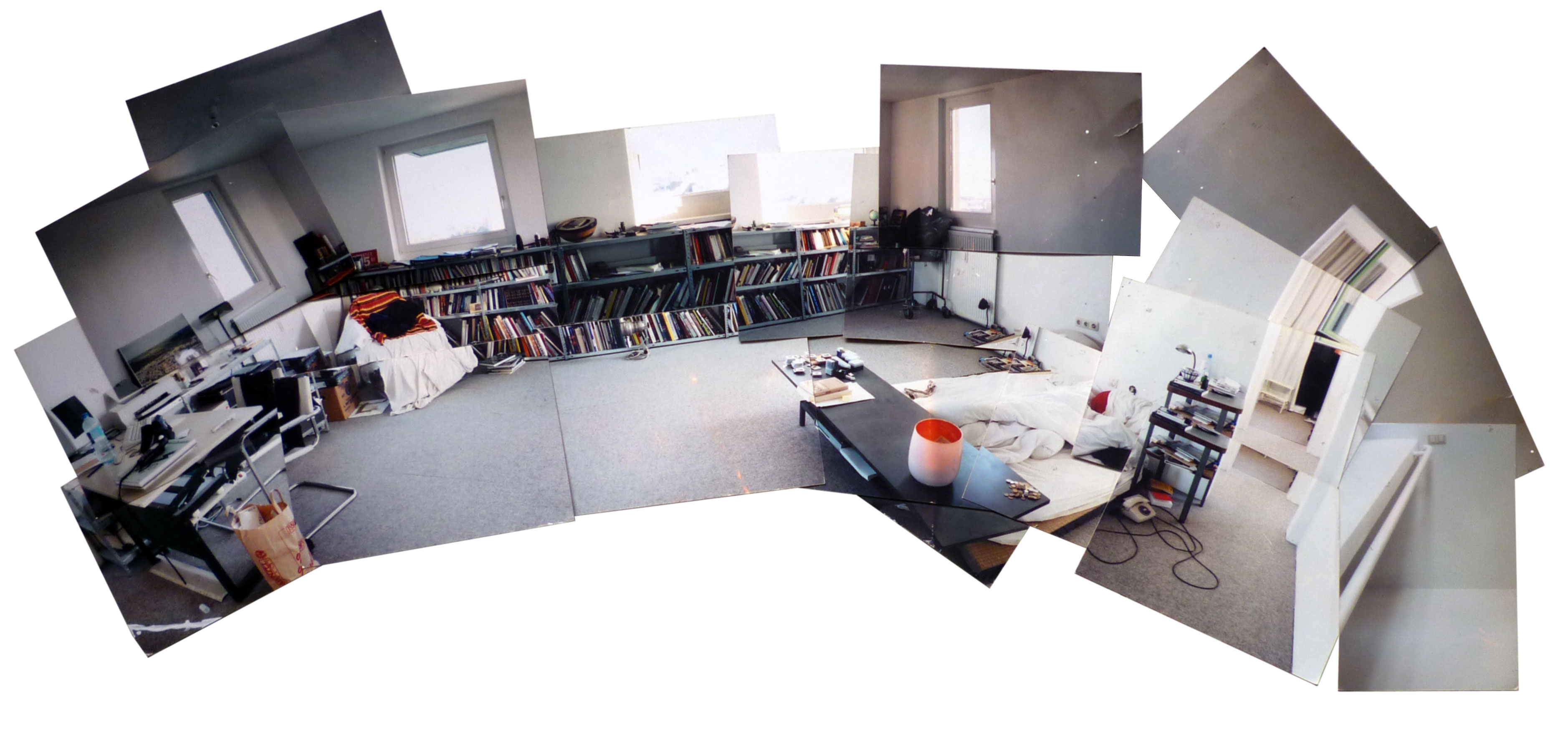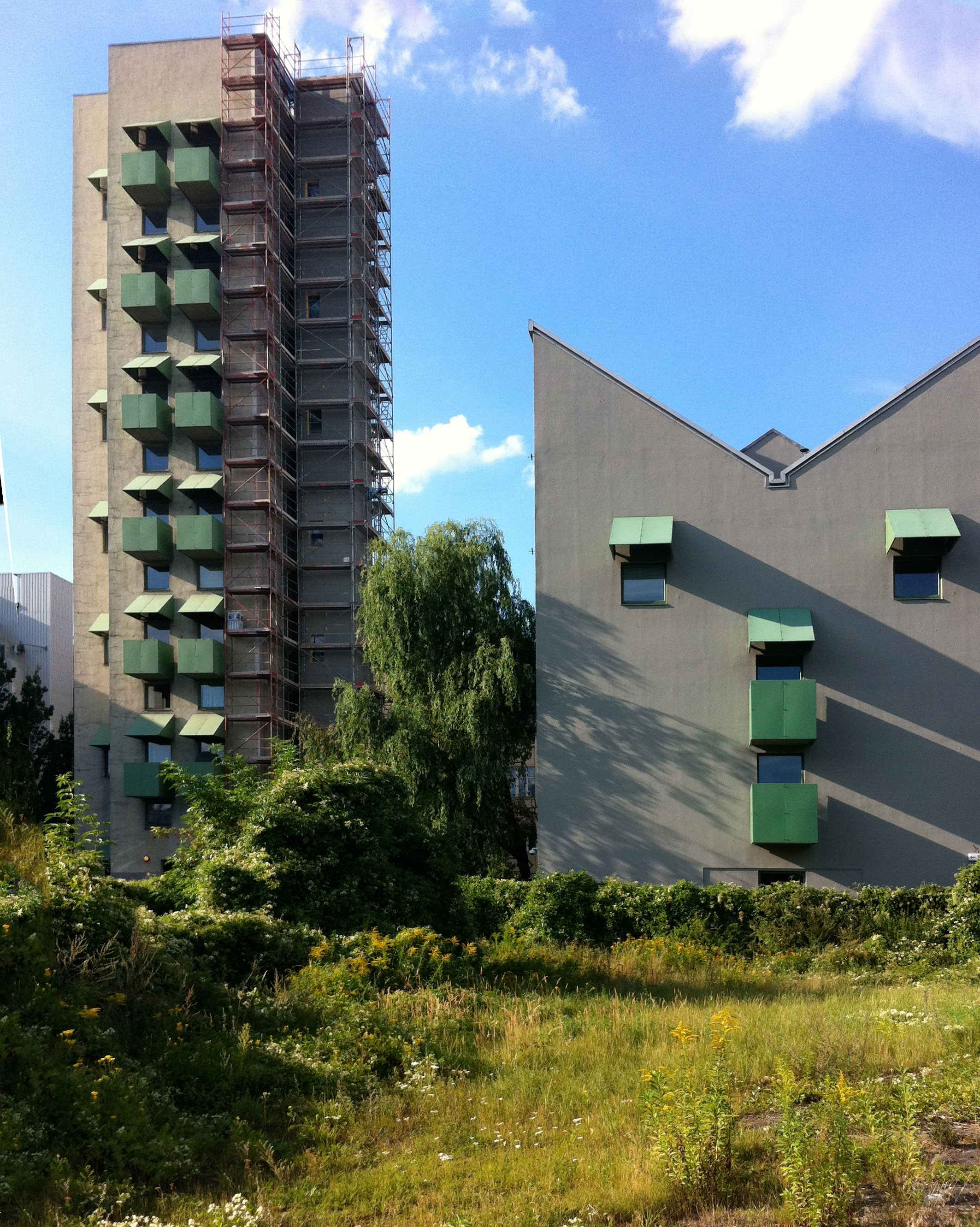Some thoughts on John Hejduk’s Kreuzberg Tower and Wings
(This is the full version of the shortened text published in uncube last month
When Christian Burckhardt from Architectuul asked me to participate in his film series “Architects in Love”, there was no question for either of us which piece of architecture should be the focus of the film. We had first met in 2010, as members of a team campaigning to influence proposed alterations to John Hejduk’s Kreuzberg Tower and Wings (1), the nature of which represented an appalling defacement of this important landmark from Berlin’s Internationale Bauausstellung. After several weeks of intense campaigning (the building works had already begun), a petition which garnered over 4,000 signatures from supporters all around the world including a host of internationally known architects, and a presentation to a Senate committee, the owner (one of the city’s largest property magnets) was convinced to abandon his original project and renovate the building as Hejduk originally envisaged. But my own “love affair” with this building goes back much further than this.
The anthropomorphism of the architecture is one aspect whose directness unfolds into more subtle, hidden dimensions over time.
Photo: Robert Slinger – CLICK IMAGE TO ENLARGE
As a young architect, I followed John Hejduk’s work with fascination and curiosity, captivated by his ability to make worlds created in a space somewhere between lived experience and imagined possibility, inhabited by an architecture which rarely made it off the paper precisely because of this unique liminal condition. As such, my first encounter with one of his rare built works, during my first visit to Berlin in 1992, was one which held not a little trepidation. Imagined architectures are always loaded with expectations which reality can seldom live up to (for myself, only the buildings of Le Corbusier have managed to consistently achieve this quality) (2).
Seeing the Kreuzberg Tower and Wings for the first time (I saw only the exterior), I was impressed by the powerful urban presence it managed to hold within its context, and the reduced architectural means employed to achieve this. But the austerity and frontal directness of the exterior initially left me with a cold, detached feeling inside. However, whether directly because of the architecture itself, or more as a result of a kind of the friction between my anticipation and the actual encounter, the experience followed me throughout the day.
Since the scaffolding came down, the powerful urban presence of the ensemble is amplified by the crisp edges of the restored facades.
Photo: Robert Slinger – CLICK IMAGE TO ENLARGE
That night I dreamt of being inside the tower, somewhere near the top, in the square, central space looking out. The dream then however took a strange, surreal turn, as dreams are wont to do. Like Alice eating cake in Wonderland, I experienced a sudden scale distortion, and my body grew to fill the volume of the building, my eyes looking out through the two windows of the south facade (3), and my hands forced out into the two small side rooms on either side of the tower, palms pressing against the small windows (4). The building became a costume, a mask through which I saw the city, forced by the architecture into a posture of supplication …. then I woke up (5).
It was to be seven more years before I got to see this interior space I had dreamt about, when through circumstances which were as random as they were fortuitous, I was given the opportunity to move into the exact same apartment in the tower, a maisonette on the 8th and 9th floors. Living there for eight years, I came to understand how Hejduk’s architecture both flexibly accommodates and at the same time asserts a presence which resists attempts to co-opt it. For me, this relationship with the tower was never an adversarial one, but rather more akin to a debate with an old friend, where differences of opinion can be explored in detail because of a given ground of mutual respect (6). Architects are especially prone to asserting their desires in the transformation of space – that’s what we’ve been skilled in. Perhaps my own biographical baggage with Hejduk’s architecture tempered my own tendencies in this respect, allowing me to listen to what the architecture wanted instead of just seeking to instrumentalise it in the service of a set of pre-formulated requirements. Hejduk himself made reference to a similar feeling when he installed an exhibition of drawings in Le Corbusier’s Villa la Roche in Paris, a feeling of hesitancy at making a hole in the wall of the building, followed by a sense of shock at the deep, blood-red colour of the plaster that came out of the hole when he finally did (7).
The black, anodized bronze stars in the buildings’ facades. Still from film “Architects in Love”
I recalled this anecdote when I first saw the building back in 1992, and in my mind I connected it to the black, anodized bronze stars seemingly driven into the buildings’ facades. These ostensibly ornamental features mark each point on the facade where the structural cross-wall, the floor plate and the facade meet – the points of invisible load transfer across the flat exterior walls. In my mind, I understood their resemblance to atomic or cosmic models as a symbolic device relating the structural condition of assembled architecture to the fundamental structure of cosmic matter. Layered onto this, the stars integrate sunlight into the architecture. When the sun shines on the facade, a flattened, distended projection of the star appears as a shadow on the flat render, moving, lengthening and distorting with the course of the day. Taking these aspects together, the stars describe a reciprocity between micro- and macro-cosmic scales, connecting the forces in a building, with those within matter, and the dynamic manifestation of the same phenomena with respect to our cosmic location – like a three-fold treatise on the subject of gravity. Living in the building gave me the opportunity to discover many such aspects hidden in the architecture, places where the frontal directness which perturbed me on my first encounter unfolds with subtlety and complexity over time.
Photocollage of the interior, ca. 1992.
Photos and collage: Robert Slinger – CLICK IMAGE TO ENLARGE
I moved out of the tower some years ago. It is always interesting to look back on the places we have called home and reflect upon where memory clings, on the mnemonic dispositives upon whose surfaces nostalgia grows with time (8). For myself, the tower’s large, square, central space, receiving natural light from four directions is one of the things that stays with me. The space felt a little too large (or too square) to be one functional unit, and a little too small to be allow more than one to coexist without interference. So occupying it was always an endeavour in synergy, looking for the right combination of eating/relaxing, sleeping/playing, living/working to bring space and lifestyle together.
The small balconies are another source of frequent recollection. Bolted onto the side of the building with a small gap between the steel-clad volume and the facade, one steps out through the wall into a forced isolation, a solitary, exposed encounter with the city. Like a telephone box or a toilet cubicle, occupying them with another person felt like an uncomfortable, transgressive act. If we had people round for dinner, and they stepped outside for a cigarette, they rarely returned to the room without commenting, often disparagingly, on the perverse disposition and anti-social nature of two small, adjacent balconies with an 80 cm gap in between them on the same facade. But seen from inside, I was fascinated by fact that, when one balcony was occupied, the next guest automatically chose the other, unoccupied unit, and then struck up a conversation with their neighbour across the little void. It was something of this quality that Claire and I played with in one of our early collaborations in 2003, when we converted the facade of the building into Berlin’s largest public clock tower.
In short, my memories of living in the tower tend largely to alight not on those elements of its architecture which accommodated my inhabitation silently, ergonomically, but rather those which challenged and surprised me, those which provoked and framed new forms of encounter.
View of the exterior during the restoration, with wasteland in front of the buildings.
Photo: Robert Slinger- CLICK IMAGE TO ENLARGE
My eldest son, Eliott, now 11 years of age, lived in the tower from the day he was born until the age of 6, and speaks of it with great affection (perhaps as one always does of the first remembered home). We rode past the other day on our bikes, and, now that the scaffolding has finally come down, we stopped briefly to look at its fresh, renewed visage (9). With the restoration now completed, the crisp edges of the immaculate rendered facades give the Tower and Wings an even stronger presence to Besselpark and against the Berlin sky than ever before. The building’s metalwork shines in it’s original green tone, a colour echoing the industrial architecture of Peter Behrens and the expressionist paintings of Max Beckmann. Eliott related to me that some of his strongest memories of living there as a youngster playing in Besselpark and on the wasteland in front of the tower were coloured with the sense that the building was watching and protecting him whatever he got up to (10).
Since love is born partly from the embrace of complementarity and the acceptance of faults, one might say that our buildings often love us more unconditionally than we do them in return (11). But in a meditation invoking by turns adoptive inhabitation and quiet observation, there is a space of empathy to be found between ourselves and our buildings which lies at the heart of that which we call Architecture.
Robert Slinger Berlin, October 2013
Notes
1. The campaign was initiated by John Hejduk’s daughter Renata Hejduk, Professor at Arizona State University. Other participants here in Berlin included Jim Hudson from the blog Architecture in Berlin, Ian Warner from blotto design and SLAB-MAG, Sven Eggers from Büro Schwimmer, Florian Koehl from FAT Koehl and Matthias Reese from rw+.
2. “The house gains immortality when it becomes only a thought that cease to exist.”*
3. “A house’s windows yearn for the sun.”*
4. “God gave man two houses, his body and his soul.”*
5. “The breath of a house is the sound of voices within.”*
6. “A house is suspicious when an armoire is introduced to an unfulfilled room.”*
7. “A wall anticipates nails being driven into it, paintings cover the punctures.”*
8. “A floor carries all the house’s vanished footprints. ”*
9. “A house closes its eyes when it is being renovated.”*
10. “The house searches for its lost occupants.”*
11. “A house knows who loves it.”*
* Quotes from “Sentences on the house and other sentences” in Hejduk, John “Pewter Wings Golden Horns Stone Veils”, Monticelli Press, 1997

